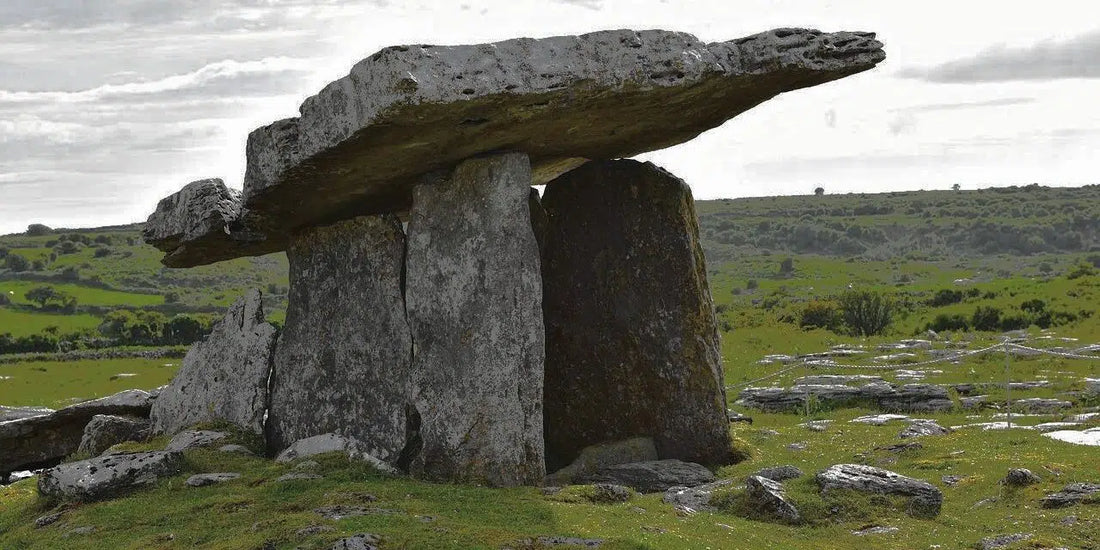
The Dolmens and the Menhirs: the mysterious gateways of the Gods
Share
When we talk about Dolmens and Menhirs we are referring to the oldest monuments existing on the planet, in fact they date back, according to many studies, to the Neolithic.
The beauty of these monuments is that no one knows their precise function even though they spread everywhere: Asia, Africa, throughout Europe and, above all, in Ireland at the famous site of Stonehenge.
What are Menhirs?
First, let's explain the word: "men" in Breton means "stone," and "hir" can be translated as "tall." The basic concept is now explained, but it's important to consider that there are menhirs measuring eighty centimeters, and others, like those at Stonehenge, that reach up to ten meters in height.
There are many observations that can be made about menhirs, as well as numerous theories regarding their true function. Menhirs are generally monolithic stone columns with broad faces running east-west and can be used to mark time, solstices and equinoxes, and provide insights into Celtic spirituality.
At least this is supposed, just as it is believed that they served as astronomical observatories. These theories actually arise from speculation based on the observations of other peoples: if the Egyptians, Greeks, Phoenicians, and others placed significant importance on astronomy, this science most likely played a central role for the Celts as well.
From the little information we have we can assume that the Menhirs represented a sort of connection with the divine, with the ultra-human.
In fact, they are capable of uniting the three worlds: the Celestial world of the deities, represented by the sky, the human world, and the underworld located underground. The Menhir touches all three, and many believe that for this reason they represented a sort of portal, a symbolic Cosmic Axis.
The Italian Menhirs
We are used to thinking of Menhirs as an exclusively Irish phenomenon, but, as already mentioned, these monuments have appeared all over the world.
There are also many menhirs in Italy: in Sardinia, for example, there are more than 100, but there are also many in Puglia. Surprisingly, few are found in Lombardy, despite it being a Celtic land.
What are Dolmens?
Starting again with the word Dolmen is more difficult because there are various interpretations. However, it seems that the Breton word "men" can always be translated as stone, but "t(d)aol" is equated with the Latin word "tabula," which would lead to a translation of "flat stone" or "stone table."
The fact is, however, that the word Dolmen does not appear to originate from the Breton language, and this has given rise to various interpretations based on various studies on the subject.
What we do know is that dolmens are stone structures arranged to create a sort of "hut." Some can accommodate people, others almost resemble altars.
There are numerous hypotheses about the Dolmens, among which it is worth mentioning the one that claims they were funerary monuments and another theory according to which these monuments were actual altars and places of worship.
In fact, nothing prevents these colossi from being used for both functions: in fact, archaeologists have found several burials near these constructions.
It is also known that the Celts found these constructions already in existence and may have used them as places of worship or as altars for certain ceremonies.
Dolmens are very fascinating because they are often real artificial hills that recall other constructions belonging to other cultures such as the Tuatha de Dannan.
Traditionally, the Celts did not perceive a clear distinction between dimensions: for them, there were portals that allowed communication between the realm of the living and that of the dead.
However, one should not think of the world of the dead as the one described by Dante, here there was in fact no Heaven and Hell but rather a place linked to the Gods and the Unknowable.
For the Celts, in the post mortem, one returned to the origin of all things, thus imitating the path of the sun and that of the moon, but also the succession of the seasons.
For the Celts, existence was cyclical, and death was merely the point where one cycle ended and another began. Note that for these people, the day began with sunset, because it was night that gave rise to day, not vice versa.
They drew this conclusion from the fact that man too was born in the darkness of the mother's womb and then came into the light, just like the chick from the egg.
For this reason, the semi-buried Dolmens were true symbols of life reborn, evolving, transforming, and changing cycles. A gateway to the world of the Gods.
Italian Dolmens
In our peninsula, Dolmens are not as abundant as Menhirs, but it must be said that in Sardinia there are many and in Puglia there are over 100.
The Italian situation also highlights how the origin of these megaliths cannot be linked to Celtic culture. The Celts discovered dolmens and menhirs and incorporated them into their cults, but they did not build them.
It is sufficient to note that the Italian regions, which are typically Celtic, are almost completely devoid of the presence of Menhirs and Dolmens, while Sardinia and Puglia seem to be the lands most affected by this phenomenon.
It is therefore possible to suppose that these megaliths come from further away and that their distribution is linked to the presence of terrestrial energy nodes which meant that these stones were also used for Christian rituals.
Even pagan culture used these constructions for its own rituals and purposes and sometimes, unfortunately, tried to destroy several examples.
All this testifies to a certain "universality of dolmens and menhirs," a power that comes from afar and adapts to all cultures and religions. It transcends history and, from generation to generation, finds itself at the center of human spiritual life.
